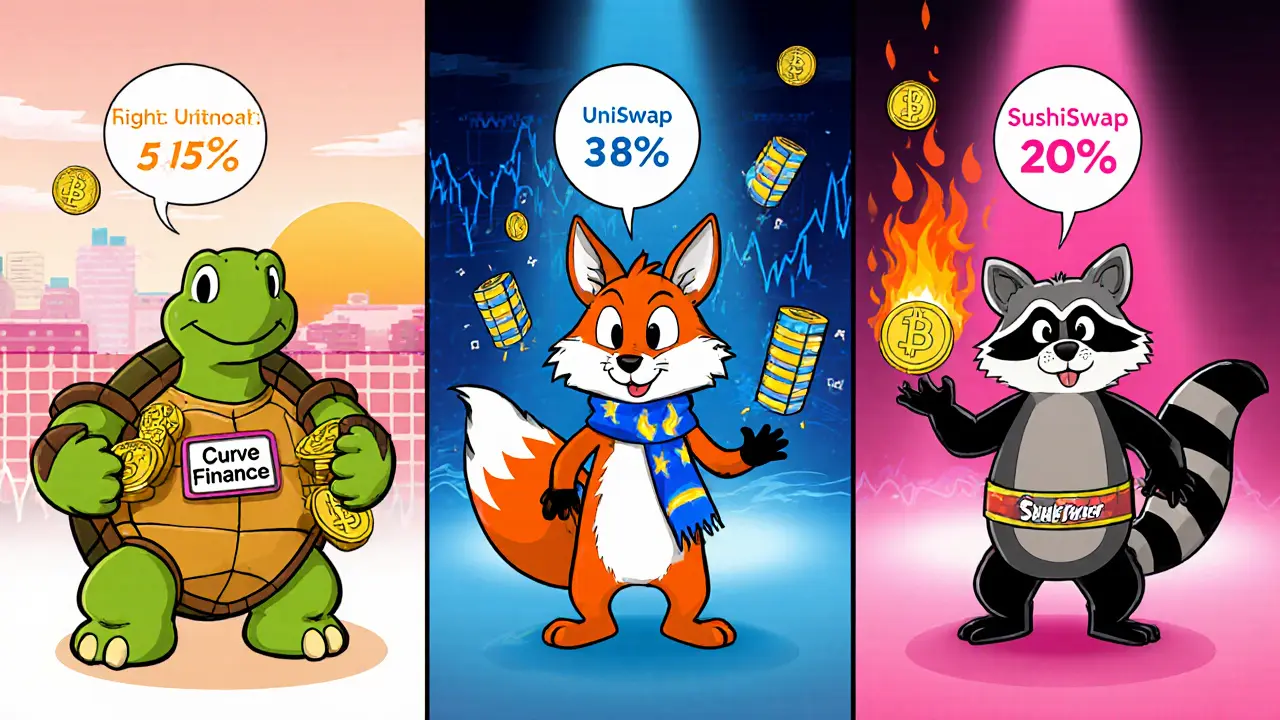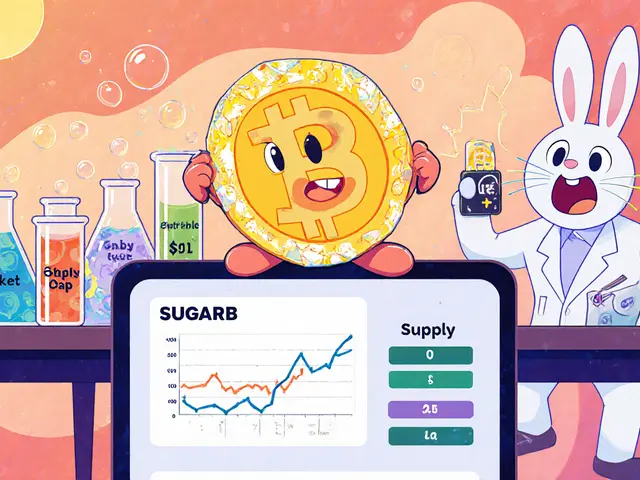
Liquidity Mining Portfolio Calculator
Your Recommended Portfolio
Portfolio Summary
Platform Comparison
Curve Finance
5-15% APY | Low Impermanent Loss
Low RiskUniswap V3
3-8% APY | Concentrated Liquidity
Medium RiskSushiSwap
50-200% APY | High Reward, High Risk
High RiskBalancer
10-30% APY | Multi-Token Pools
Medium RiskBancor
8-12% APY | Single-Sided Staking
Low RiskYearn Finance
20-40% APY | Auto-Compounding
Medium RiskLiquidity mining has become the go‑to way for crypto holders to earn passive income, but the space is crowded and returns vary wildly. Below is a quick‑hit TL;DR so you can decide which farms are worth a deeper look.
- For low‑risk, stable returns: Curve Finance stablecoin pools (5‑15% APY, minimal impermanent loss).
- For balanced exposure with moderate fees: Uniswap V3 range orders on Ethereum (3‑8% fee‑share plus token rewards).
- For high‑risk, high‑reward early‑stage tokens: SushiSwap seasonal campaigns (50‑200% APY, higher gas and volatility).
- For portfolio‑diversified pools and custom weights: Balancer multi‑token pools (10‑30% APY, single‑side options).
- For single‑sided, low‑impermanent‑loss staking: Bancor (8‑12% APY, algorithmic market‑making).
What is Liquidity Mining?
At its core, Liquidity mining is a DeFi incentive model where users deposit crypto into a pool that powers trading or lending. In exchange, the protocol mints liquidity provider (LP) tokens that represent your share and automatically allocate a slice of trading fees, governance tokens, or both.
Since the “DeFi Summer” of 2020, dozens of platforms have layered additional reward programs on top of the basic fee‑share, creating a market where APYs can swing from single digits to triple‑digit bursts. Understanding the mechanics-especially impermanent loss and smart‑contract risk-is essential before you commit capital.
How to Evaluate a Liquidity Mining Opportunity
Every potential farm can be broken down into four decision factors:
- Yield potential: Look at the advertised APY, but also consider fee share, token inflation, and boost mechanisms (e.g., veCRV on Curve).
- Risk profile: Gauge smart‑contract audits, platform age, and exposure to impermanent loss. Stablecoin pairs score low; volatile alt‑coin pairs score high.
- Transaction costs: On Ethereum, gas can eat 30‑50% of small positions. Layer‑2s (Polygon, Arbitrum) or alternative chains (BSC, Avalanche) often cut fees dramatically.
- Liquidity depth: Deep pools reduce slippage and provide more stable fee income. Shallow pools can be lucrative but are prone to price swings.
Best Platforms in 2025
Below is a snapshot of the most reputable platforms, their sweet spots, and the typical returns you can expect.
| Platform | Typical APY Range | Required Token(s) | Fee % (on swaps) | Single‑Sided? | Best For | Main Risks |
|---|---|---|---|---|---|---|
| Uniswap | 3‑8% (fee share) + token rewards | Any ERC‑20 pair (50‑50) | 0.30% | No | Broad exposure, easy entry | Impermanent loss, high gas |
| Curve Finance | 5‑15% (fees + CRV boost) | Stablecoin or similar‑value pairs | 0.04%‑0.04% | No | Low‑risk stable yields | Lower token rewards, limited pairs |
| SushiSwap | 50‑200% (seasonal campaigns) | Varies; often new tokens | 0.30% | No | High‑reward early projects | Volatility, impermanent loss |
| Balancer | 10‑30% (fees + BAL rewards) | Custom multi‑token pools | 0.05%‑0.30% (varies) | Yes (single‑side pools available) | Portfolio diversification | Complex UI, smart‑contract risk |
| Bancor | 8‑12% (single‑side + token rewards) | Single token (any ERC‑20) | 0.10%‑0.20% | Yes | Simplified entry, low impermanent loss | Algorithmic pricing risk |
| Yearn Finance | 20‑40% (auto‑compounded vaults) | Depends on vault (USDC, ETH, etc.) | Variable (depends on underlying protocol) | No | Hands‑off optimization | Complex strategies, audit exposure |
Deep Dive into the Top Five Opportunities
1. Curve Finance Stablecoin Pools
Curve’s AMM is engineered for assets that trade at near‑par-think USDC/USDT, DAI/USDT, or the BTC‑like “renBTC”/“WBTC” pair. Because price deviation is minimal, impermanent loss is virtually zero. Fees sit at a razor‑thin 0.04%, but the platform distributes CRV tokens that can be locked as veCRV to boost rewards up to 2‑3×. A typical 30‑day snapshot in October 2025 showed 7.2% fee‑share plus a 3.5% CRV boost for a 10‑day lock.
2. Uniswap V3 Concentrated Liquidity
Uniswap’s newest version lets you allocate liquidity to custom price ranges, turning the classic 50‑50 pool into a “concentrated” position. If you anticipate ETH trading between $1,800‑$2,300, you can lock all your capital in that window, earning a higher fraction of the 0.30% swap fees. The trade‑off: your LP token value drops sharply if price exits the range, mimicking an impermanent loss but on a tighter scale. For most retail traders, a 0.5‑1% APY from fees plus the occasional UNI token airdrop makes it a solid baseline.
3. SushiSwap Seasonal Yield Farms
SushiSwap frequently launches “Onsen” farms for brand‑new tokens. In the last quarter, the $KNOX token farm on Polygon peaked at 162% APY, driven by both swap fees (0.25%) and a massive SUSHI reward emission. When the campaign ends, rates plummet, so many users stagger entries-deposit a portion now, add more later, and withdraw before the final week. The upside is huge, but you must be ready for price swings, higher gas on Ethereum‑based pairs, and occasional rug pulls.
4. Balancer Custom Weight Pools
Balancer lets you design a pool with up to eight tokens and assign each a weight (e.g., 40% ETH, 30% WBTC, 30% USDC). The protocol then rebalances automatically, turning your pool into a self‑adjusting portfolio. BAL token emissions add another layer of yield. A popular “DeFi Index” pool posted a 13% APY in September 2025, with low volatility thanks to the USDC cushion. New users should start with a pre‑built Balancer template to avoid configuration errors.
5. Bancor Single‑Sided Staking
Bancor’s “single‑side” model means you can provide just BNT and still earn a slice of the pool’s fees and BNT token rewards. The protocol’s “Bancor Relay” adds a synthetic stablecoin layer that dampens price drift, meaning impermanent loss is often under 2% annually. In Q3 2025, the BNT/ETH relay returned roughly 9% APY after fees, making it a hands‑off alternative for those who dislike managing paired assets.

Layer‑2 & Cross‑Chain Opportunities
Ethereum’s gas surge remains the biggest head‑wind for small‑scale miners. To keep more of your earnings, consider these roll‑ups:
- Polygon: SushiSwap and Curve both have Polygon versions with fees under $0.01 per transaction. APYs are similar, but after‑gas returns can be 2‑3× higher.
- Arbitrum: Uniswap V3 on Arbitrum offers the same concentrated liquidity features with ~80% cheaper gas.
- Optimism: Balancer’s Optimism deployment enables multi‑token pools with near‑instant finality and reduced bridge risk.
Cross‑chain bridges (e.g., Wormhole, Hop) open up liquidity on Solana, Avalanche, and BNB Chain, but each adds a “bridge risk” - the chance the bridge smart contract is hacked or paused. Use reputable, audited bridges and keep the amount bridged small until you’re comfortable.
Risk Management Checklist
- Verify the platform’s audit reports - look for recent third‑party audits (e.g., Trail of Bits, Quantstamp).
- Calculate potential impermanent loss using an online calculator before committing.
- Factor gas fees: on Ethereum, aim for positions > $10,000 to keep fees under 5% of earnings.
- Diversify across at least three platforms and two asset classes (stable vs volatile).
- Set stop‑loss or “farm exit” dates - many high‑APY farms decay after the incentive period.
Putting It All Together - Sample Portfolio
Imagine you have $30,000 to allocate. A balanced DeFi yield portfolio could look like:
- $10,000 in Curve’s USDC/USDT pool (stable, 7% net APY after CRV boost).
- $7,000 in Uniswap V3 ETH/USDC concentrated range (estimated 5% fee‑share APY).
- $5,000 in a Balancer DeFi Index (13% APY, diversified across ETH, BTC, USDC).
- $5,000 in a SushiSwap Onsen farm on Polygon (high‑risk token, 120% APY but only for 30 days).
- $3,000 in Bancor single‑side BNT (9% APY, low impermanent loss).
This mix targets a weighted average of ~20% annual return, with only ~15% of capital exposed to high volatility. Re‑balance every quarter, pull out of short‑term farms once their reward emissions dip, and roll the proceeds into the next high‑yield opportunity.
Staying Informed - Where to Track Updates
DeFi moves fast. Follow these sources for the latest APY changes, new incentive programs, and security alerts:
- DeFi Pulse and Dune Analytics dashboards (real‑time TVL and APR data).
- Twitter accounts of protocol core developers (e.g., @uniswap, @sushiswap).
- Subreddits r/defi and r/ethfinance for community intel.
- Newsletter “The Defiant” for deep dives and regulatory news.
Final Thoughts
There’s no single “best” farm - the optimal choice hinges on how much risk you’re comfortable taking, which chain you prefer, and how actively you want to manage positions. Start small, master the mechanics on a low‑risk platform like Curve, then expand into higher‑yield farms as you gain confidence. Keep your smart‑contract risk checklist handy, and always remember that the highest APY usually comes with the steepest downside.

Frequently Asked Questions
What is impermanent loss and how can I avoid it?
Impermanent loss occurs when the price of the assets you supplied diverges from the ratio you deposited. The loss is “impermanent” because it can be recovered if prices return to the original balance. To minimize it, stick to stablecoin pairs (Curve), use concentrated liquidity within a narrow price window (Uniswap V3), or choose single‑sided pools (Bancor) that automatically rebalance.
How do I claim rewards on these platforms?
Each protocol has a “Claim” button in its UI. For example, on Uniswap you go to the “Pool” page, select your LP token, and click “Harvest”. On Curve, rewards accrue in your wallet and can be harvested via the “Rewards” tab. Some platforms, like Yearn, auto‑compound, so you don’t need to manually claim.
Are liquidity mining returns taxable?
In most jurisdictions, token rewards are treated as ordinary income at the time you receive them, and any later sale triggers capital gains. New Zealand, for example, taxes crypto income if you’re trading as a business. Always consult a local tax professional for your specific situation.
Which layer‑2 should I choose for the best gas savings?
Polygon offers the lowest fees for small‑scale users, often under $0.01 per transaction. Arbitrum provides a balance of lower fees and robust security, while Optimism is fast‑growing with many DeFi apps ported. Your choice may also depend on which platform you want to farm on - check whether the protocol has a native deployment on the roll‑up you prefer.
How often should I rebalance my liquidity positions?
Quarterly reviews work for most retail investors. If you’re in a high‑velocity farm (e.g., SushiSwap seasonal pools), check weekly for reward decay. Rebalance when fees drop below a threshold or when a pool’s price range moves out of your concentrated window.





